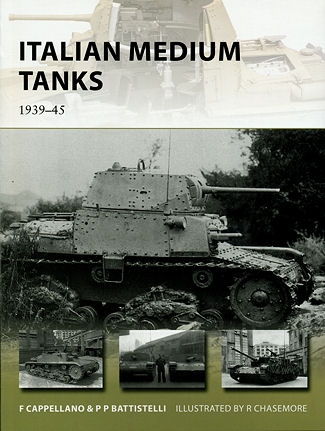 Of
the three major Axis powers, two of them, Japan and Italy were woefully lacking
in decent tanks. Both of them were basing their tanks on what was needed for
colonial occupation and for the battles of the 1930s. As such, much of what they
did have were light tanks. Those medium tanks that existed were under-gunned,
under-armored, and slow.
Of
the three major Axis powers, two of them, Japan and Italy were woefully lacking
in decent tanks. Both of them were basing their tanks on what was needed for
colonial occupation and for the battles of the 1930s. As such, much of what they
did have were light tanks. Those medium tanks that existed were under-gunned,
under-armored, and slow.
For the Italians, they envisioned a lot of hill and mountain fighting,
where heavy tanks were not going to to be operating. They also had to take into
the consideration the various bridges where they thought they would be
operating. Bridges that could not handle heavy tank traffic. As such, their
medium tanks were relative lightweights in terms of tonnage and still in the
1930s with their small 37mm guns. They had not figured out welding so the vast
majority of their armor plating was bolted on.
Early battles in the 1940s against British armor and British anti-tank
guns showed that the tanks being used were obsolete even before they entered the
battle field. Their slow pace meant they were easily over run by the faster,
though similarly armed 'cruiser' tanks and they were totally unable to defeat
the heavily armored infantry support tanks like the Matilda.
Despite constant upgrading, Italian tanks always seemed to be a year or
two behind the curve. However, not all was as dire and depressing as it seems
for out of this the Italians developed the Semovente or tank destroyer class of
vehicles similar to the German StuGs. These had sufficiently large guns to be
effective against enemy armor. They were faster than the normal medium tank and
they were lower in profile, something that was important when ambushing enemy
armor. However, the pace of construction of these tanks was slow, something that
plagued Italian war production of all materiel during the war.
Even after the armistice in September of 1943, those factories under
German occupation continued to produce tanks and even some updated versions not
available earlier. The older tanks were farmed out to the Aegean and other areas
where they were more than satisfactory against partisans. These were used until
unable to operate due to a lack of spare parts.
In line with other books in this series, the authors cover the
development and construction of the various medium tanks and the semovente from
which they were derived. We get to look at their strengths and weaknesses as
well as how they did in battle, both with the Italian and German army. It is
surprising how many actually survived the war long enough to be placed in
various museums and other display venues.
It all makes for a book on a subject about which few enthusiasts are
conversant. It is a superb look at these vehicle and how they were used in
combat. A book that is both interesting and enjoyable to read. A book I can
easily recommend for you.
January 2013
For more on the complete line of Osprey books,
visit www.ospreypublishing.com. In the US, it is
Osprey Direct at 44-02 23rd St, Suite 219, Long Island City, NY 11101., where you can
get a catalogue of available books.
If you would like your product reviewed fairly and quickly, please
contact
me or see other details in the Note to
Contributors.
 Of
the three major Axis powers, two of them, Japan and Italy were woefully lacking
in decent tanks. Both of them were basing their tanks on what was needed for
colonial occupation and for the battles of the 1930s. As such, much of what they
did have were light tanks. Those medium tanks that existed were under-gunned,
under-armored, and slow.
Of
the three major Axis powers, two of them, Japan and Italy were woefully lacking
in decent tanks. Both of them were basing their tanks on what was needed for
colonial occupation and for the battles of the 1930s. As such, much of what they
did have were light tanks. Those medium tanks that existed were under-gunned,
under-armored, and slow.